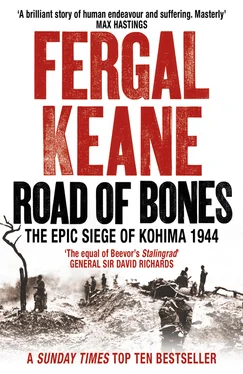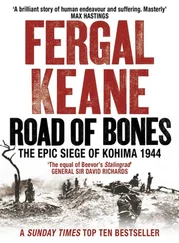Christison’s immediate priority was to restore the morale of the men under his command. He decided that worms might be a factor contributing to poor morale. He set about removing men from the line, giving them a de-worming treatment and a fortnight’s rest at the coast playing games on the sand. At the end of this, he reported, ‘they were raring to have a go at the Japs’.
As the end of 1943 approached, Slim and Christison made final plans for an offensive in the Arakan. The main target was the island port of Akyab, 120 miles south of the Indian frontier on the Bay of Bengal. Akyab offered strategic airfields and access to the main waterways of the Arakan. Whether the allies ultimately decided to try and retake Burma by land or by sea, or a combination of both, they were going to need air cover all the way to Rangoon. Akyab offered the best facilities. The operation would also pre-empt any Japanese attempt to use Akyab as a base to encroach into India.
There was also another, more directly political, reason for an assault towards Akyab. The airfields had been used to launch Japanese raids on Calcutta at the end of the previous year, a strike that had little military importance but had sent thousands of refugees flooding into the countryside where there had already been massive displacement due to the famine of the previous year. There were five hundred civilian casualties and only a tenth of the normal workforce remained at work on the docks. The 5 December raid also saw fear-stricken merchants close down their grain shops, forcing the government to requisition stocks in order to avoid civil unrest. ‘A false alert the following day did nothing to improve morale in the city,’ the official history noted. Any suggestion of Japanese strength undermined attempts to project to the Indian population the image of an unruffled Raj.
The original plan was to mount a joint sea and land operation but at the last moment the landing craft were taken away for use in Europe. General Christison’s 15 Corps would have to do it the hard way, advancing overland in a three-pronged attack on Japanese positions on both sides of the Mayu range. To blast them out, Slim’s artillerymen would use their 5.5 inch guns, although the armchair generals in Delhi feared they would never succeed in hauling them into the mountains. ‘Stroking their “Poona” moustaches,’ a young officer wrote, ‘they remarked that these pieces would never get over the trails and through the jungle of Burma.’ As in so much else, Slim’s soldiers would prove the doubters wrong.
*The official breakdown of these figures is 916 killed, 2,889 wounded, and 1,252 missing, including prisoners of war. S. Woodburn Kirby, The War Against Japan , vol. 2: India’s Most Dangerous Hour (HMSO, 1958).
*What American opinion tended to ignore was the human cost of the USA’s own expansion. The conquest of the West had been achieved only at the expense of the native tribes. The inhabitants of Hawaii, Puerto Rico and the Philippines, where America had fought a savage war of conquest, had been given no say over the annexation of their lands. The racist segregation within the American army, to say nothing of the discrimination practised in the Southern states of the USA, suggest a convenient myopia on the part of those who condemned Churchill for his imperial revanchism. Roosevelt could himself adopt a tone of condescension towards Asians which would have resonated with the most reactionary of British imperialists. Writing to Churchill on 16th April, 1942 he declared: ‘I have never liked Burma or the Burmese and you people must have had a terrible time with them for the last fifty years. Thank the Lord you have HE-SAW, WE-SAW, YOU-SAW under lock and key. I wish you could out the whole bunch of them into a frying pan with a wall around it and let them stew in their own juice.’ (PSF/BOX37/A333EE01, Franklin D.Roosevelt Presidential Library and Museum.)
*In such circumstances, Churchill wrote, ‘the United States Government would after the victory feel greatly strengthened in its view that all possessions in the East Indian Archipelago should be placed under some international body upon which the United States would exercise decisive control.’ (Winston Churchill memo, 29 February 1944, cited p. 412, Allies of A Kind , Christopher Thorne, Oxford University Press, 1978.)
†With this aim in mind work began in late 1942 to build a 400-mile-long road across mountains and through jungles to connect the railhead at Ledo in Assam with the 717-mile road that ran from Lashio in Burma to Kunming in China. The new road would bypass the part of the old ‘Burma Road’ now in Japanese hands. This immense project was driven forward by the American general Joseph ‘Vinegar Joe’ Stilwell, chief of staff to Generalissimo Chiang Kai-shek. It involved 17,000 American engineers and around 50,000 Indian labourers and huge numbers of Chinese troops. From the outset Slim was sceptical, writing that ‘if it were left to me I would have used the immense resources required for this road, not to build a highway to China, but to bring forward the largest possible combat forces to destroy the Japanese army in Burma.’ (p. 249, Defeat Into Victory , Field Marshal Sir William Slim, Cassell, and Company Ltd, 1956.) Completed in January 1945, the ‘Ledo Road’ contributed little to the defeat of Japan. The airlift on the ‘Hump’ route across the Himalayas delivered more than four times the amount of war materiel to the Chinese Nationalists than the ‘Ledo Road’. The plan to use bases in China to attack Japan proved a failure. When American raids were launched from bases in Eastern China in May 1944 the Japanese counter-attacked furiously and by January 1945 forced the removal of the bombers to India and thence to the Mariana Islands where the major bombing effort against Japan was based. A US Army historical analysis concluded that ‘the air effort in China without the protection of an efficient Chinese Army fulfilled few of the goals proclaimed for it.’ (‘World War II: The War Against Japan’, Robert W. Coakley, American Military History, Army Historical Series, Office of the Chief of Military History, United States Army, Washington, 1989.)
*Eight million Indians were employed on war-related work during this period.
* The Official History , vol. 111, p. 317, gives a total of 41 for Assam, Manipur, Eastern Bengal and Calcutta.
*Even before war broke out there had been problems. As early as August 1939 a Sikh platoon in the Punjab Regiment deserted after a religious leader ‘so lowered their spirit that they deserted rather than face the dangers of war’. Later that year a group of Sikhs in Egypt rebelled when asked to load lorries, believing such coolie work was beneath them. A year after the first outbreak in the Punjab a squadron of the Central India Horse refused to board ship in Bombay. A mutiny and hunger strike among Sikhs of the Hong Kong and Singapore Royal Artillery in 1940 was provoked by orders that the men should wear solar topis. The investigators sent from India blamed the ‘faulty administration’ and told the regiment to back down on the helmet order. The troubles prompted one far-seeing intelligence officer, Colonel Wren, to write in 1940: ‘We have by our policies towards India, bred a new class of [Indian] officer who may be loyal to India and perhaps to Congress but is not necessarily loyal to us … The army would be helped by a more positive policy on the part of His Majesty’s Government … which will transform our promises of independence for India into reality in the minds of the politically minded younger generations.’
*The desire to escape the hellish conditions of Japanese prisoner of war camps was a decisive factor for many. Among the officers there were undoubtedly substantial numbers who had been alienated by the racist treatment they received at the hands of colonial officials in pre-war Malaya. This could range from being forced to sit in separate compartments from Europeans on trains and excluded from clubs where a colour bar operated. The INA also drew thousands of recruits from Indian communities in South-East Asia, many of them from the rubber plantations of Malaya and drawn by Bose’s promise of a new India in which the restrictions of caste would be overturned.
Читать дальше












